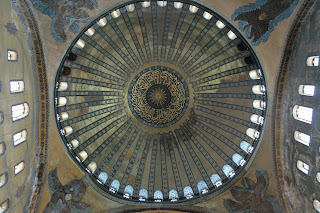Though cathedrals are obvious works of art, and admired as such, for reasons mostly having to do with narrow-mindedness, I had not been prepared to admire the mosques of Istanbul as such. Next June when I return, I hope to take additional pictures of the more than 3000 mosques in Istanbul.
There are so many mosques, that
adhan (prayer call, but literally meaning permit+ear) overlap and seemingly compete with one another during the five times of the day when devout Muslims must commune with God, mandatory prayers known as
fard salah. The minarets served a very practical function before loudspeakers by providing the
muezzin a high place from which to chant the invitation to prayer, and then the second call,
iqama, which instructs muslims to prepare to pray. The interval time allows those praying to clean their hands and face at fountains found outside each mosque.
Arabic is the official liturgical language in Turkey. As a part of the secularization of Turkey under Ataturk, Arabic was removed at prayer but reinstated in 1950. The Turkish language is full of many international 20th century words precisely because the establishment of the Republic of Turkey in 1923 provided a platform for secularization that embraced words and ways of the Western world.
Of course the most famous mosque in Istanbul is the Blue Mosque, directly across from the Saint Sofia museum which was once a basilica and then a mosque before being turned into a public cultural space by Ataturk. More on both of those another time.
























 Lastly, I had no idea that the colors of mosaics could be so varied, permitting a subtlety in the visual effect. It can not be seen at a distance but a close-up shows how many variants on a hue were used to produce a bright effect. Originally the colors would have been so bright, polished and cared for in the court life. They can not be polished or wet now to show their vividness simply because they are antiques and precious as is. Though that makes perfect sense, I wish it were possible to see these mosaics in all their original splendor.
Lastly, I had no idea that the colors of mosaics could be so varied, permitting a subtlety in the visual effect. It can not be seen at a distance but a close-up shows how many variants on a hue were used to produce a bright effect. Originally the colors would have been so bright, polished and cared for in the court life. They can not be polished or wet now to show their vividness simply because they are antiques and precious as is. Though that makes perfect sense, I wish it were possible to see these mosaics in all their original splendor.